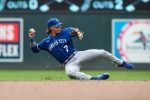Why the Dodgers’ playoffs pitching blueprint won’t change

LOS ANGELES — The circumstances yearned for reassessment, but Los Angeles Dodgers manager Dave Roberts didn’t entertain it. Clayton Kershaw had put together the worst start of his illustrious career, on the heels of a two-month stretch in which he was clearly limited by a balky left shoulder, but Roberts didn’t deviate from his plan.
Kershaw, Roberts said Saturday night, then reiterated again Sunday morning, will make his next scheduled start against the Arizona Diamondbacks in Game 4 on Thursday, if this National League Division Series even gets there.
“For us to accomplish what we want to this year,” Roberts said, “we’re going to need Clayton Kershaw to start baseball games.”
And therein lies the vulnerability of these Dodgers, a 100-win team that is far from a juggernaut because of the uncertainty throughout its starting rotation.
The Dodgers went into this postseason looking to make up for a glaring deficiency with unconventionality, utilizing openers and bridge starters and a heavy dose of high-leverage relievers to piece together victories in October. It’s a volatile plan born out of necessity, but its success hinged on Kershaw providing four to five quality innings on his start days. It’s why the results of his Game 1 outing Saturday night — six runs allowed and one out recorded, becoming only the fourth starting pitcher in postseason history with such a line — were so concerning.
Kershaw is the only man remaining from the Dodgers’ initial rotation of the season. Dustin May and Tony Gonsolin underwent season-ending surgeries; Noah Syndergaard struggled mightily before being traded away; Walker Buehler didn’t make it back from his second Tommy John surgery in time to help; Julio Urias went on administrative leave after allegations of domestic violence; and midseason pursuits of Justin Verlander and Eduardo Rodriguez fell through.
The Dodgers knew Kershaw would be limited in the postseason, but they expected him to be effective. Upon his return from a six-week stint on the injured list in early August, they spaced out Kershaw’s starts and shortened them to about five innings at a time. He delivered under those constraints, posting an ERA under 3.00 despite a fastball that was mostly clocked around 88 mph.
That, the Dodgers thought, would be enough for a pitching staff that would ask a lot out of a foursome of rookies that includes Bobby Miller, Ryan Pepiot, Emmet Sheehan and Michael Grove.
Now the Dodgers don’t know what to expect from their most accomplished pitcher.
We’ve got you covered on all things October baseball.
Schedule, bracket, standings »
World Series odds, LDS preview »
Our predictions for every round »
Kershaw emphasized Saturday that his Game 1 struggles were not health related. “Just bad pitching,” he said. Roberts noted that Kershaw’s stuff was relatively sharp; all 17 of Kershaw’s fastballs were 90 to 91 mph. It’s a source of optimism, but also, considering the damage levied against him by an exceedingly aggressive offense, a reason to worry.
“I think that’s fair,” Roberts said when asked if it’s more concerning that Kershaw struggled despite an uptick in velocity. “I would still bet on the stuff being good than the stuff being down and not sharp. So now it’s how we attack these guys. It’s a game of adjustments. It really is. I still stand by the fact that he’s healthy. The stuff played up, and now we’ve just got to make better pitches.”
The Dodgers have been as celebrated for their regular-season prowess as they have been chastised for their postseason shortcomings, most notably their division series exits at the hands of the Washington Nationals in 2019 and the San Diego Padres in 2022. Despite their standing as one of this era’s most successful franchises, they have been panned for frequently falling short of expectations in October, a label that has followed Kershaw for most of his career. But the circumstances are vastly different now. The Dodgers are noticeably shorthanded, and Kershaw, 35, is seemingly not right.
A longtime scout who watched Kershaw pitch frequently down the stretch said his stuff was “about a third down” over the last two months of the regular season. The metrics support that. Stuff+ grades the physical characteristics of pitches by factoring velocity, spin rate, movement and release point, among other aspects, with 100 being league average. Kershaw’s Stuff+ from 2021 to 2022 was 110. From April to July of this season, it was 108. From August to September, it was all the way down to 83. In other words, 17% below league average.
Check out our best Dodgers coverage from this season as they get ready for the 2023 playoffs.
Inside Dodgers’ pitching plan for playoffs »
5 reasons they keep winning »
How Mookie Betts became an infielder »
On Saturday, he combined that with center-cut fastballs and an inadequate feel for his breaking pitches.
Said the scout: “Diminished stuff with poor location is a bad combo.”
Miller, the 24-year-old right-hander with electric stuff but no prior postseason experience, will take the ball opposite Cy Young contender Zac Gallen in Game 2 from Dodger Stadium on Monday night. Roberts said he “couldn’t even sit here and tell you what Game 3 looks like,” though Pepiot and Lance Lynn tag-teaming two-thirds of it stands out as a possibility.
After that, if the Dodgers win at least once, it’ll swing back to Kershaw.
They don’t have much choice.
“There’s certain people that get you here that have to get you across the finish line,” Roberts said, “and this is his role on our ballclub.”